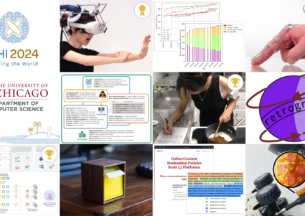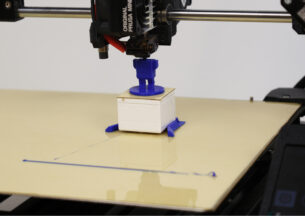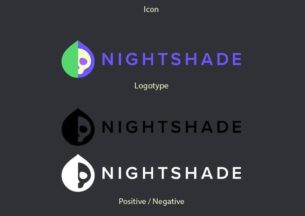Computer Science Displays Catch Attention at MSI’s Annual Robot Block Party
For the second year in a row, research groups from the University of Chicago’s Department of Computer Science had the opportunity to educate and impress 19,000 museum visitors with their interactive displays at the Museum of Science and Industry’s Robot Block Party. The annual event celebrates National Robotics Week and aims to show guests of all ages how robotics and computer science are changing the landscape of our everyday life. Eight groups and over 40 department members demonstrated their work on topics ranging from 3D modeling and data privacy to AI and actuated technology.
AxLab- Actuated User Interfaces
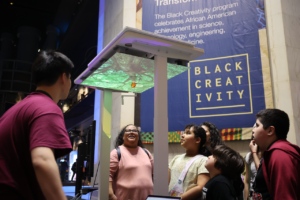 “The audience is multi-generational: kids and their family form a significant portion of attendees,” said PhD student Willa Yang, who represented Assistant Professor Ken Nakagaki’s Actuated Experience Lab (AxLab) during the event. “Children were particularly drawn to our prototype, calling it “magic”. They would play with it and bring their families to see it as well. Some parents expressed curiosity about the technology behind it and its potential applications.”
“The audience is multi-generational: kids and their family form a significant portion of attendees,” said PhD student Willa Yang, who represented Assistant Professor Ken Nakagaki’s Actuated Experience Lab (AxLab) during the event. “Children were particularly drawn to our prototype, calling it “magic”. They would play with it and bring their families to see it as well. Some parents expressed curiosity about the technology behind it and its potential applications.”
The “magic” display exhibited the latest research in actuated user interface technologies. One demonstration showed small robots moving around a colorful ceiling to help guests visualize how robots can enrich our unused space. Their second display featured an interactive mobile device that expands and changes shape to demonstrate a different type of gaming controller.
Nakagaki’s Actuated UIs & Tech Class had their own table with an interactive map to show clusters of COVID cases. Guests could move a slider knob to change the date and see the different clusters of COVID cases in Illinois during that time. Small robots would then automatically rearrange themselves to indicate optimal placement of clinics, hospitals, and tents.
HRI Lab- Human Robot Interaction
Assistant Professor Sarah Sebo’s Human Robot Interaction (HRI) Lab was set up in the center of the main rotunda with three “traditional” robots. Kids were antsy to get a chance to play with them and could be seen listening intently during demonstrations.
“We let children program modular robotic systems using a drag-and-drop programming application,” said PhD student, Alex Zhang. “Kids were so into programming the robots that arguments broke out over who got to interact with the system. While quarrels are not great, it’s pretty amazing to see how great of a pull these systems can have on perpetually curious children.”
It wasn’t only kids who benefited from HRI’s exhibit, but also some researchers themselves. One of the students from the HRI Lab made a connection with robotics masters from Northwestern and learned they had a large software library that would be a critical timesaver on future research. The students were able to share information at the event, speaking volumes on the impact that outreach efforts can have for everyone.
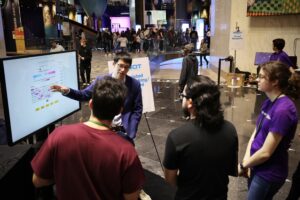 CHAI Lab- Artificial Intelligence
CHAI Lab- Artificial Intelligence
Also in the center was Assistant Professor Chenhao Tan’s Chicago Human+AI (CHAI) Lab. Their booth focused on AI-assisted decision making and showed a paragraph with highlighted words explaining where an AI model relies most on text classification tasks, such as if it were predicting someone’s profession. By making AI models more transparent, the group hopes to lay a foundation for more trustworthy and effective human-AI collaborations.
SUPER Group- Privacy & Security
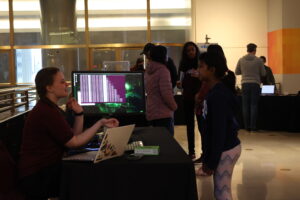 Some groups used a more nuanced way of getting their point across. Neubauer Family Assistant Professor Blase Ur’s Security, Useability, Privacy, Education, and Research (SUPER) Group prompted guests to have discussions surrounding controlled speech. Their system generated live subtitles for speech and augmented the text with audiovisual effects, but with a catch; the user did not have agency over the images produced and had to accept that some words may be censored with a loud beep while others were applauded. The system was designed to look for negative statements and replace them with positive ones: for example, if someone said “I don’t like science”, the subtitles may display “I like science” instead as a subtly sinister way of “encouraging” (or enforcing) positivity. Examples like this were used to encourage visitors to think critically about how their intended online image may be subtly twisted based on a platform’s ideals rather than their own if they consented to the platform’s rules.
Some groups used a more nuanced way of getting their point across. Neubauer Family Assistant Professor Blase Ur’s Security, Useability, Privacy, Education, and Research (SUPER) Group prompted guests to have discussions surrounding controlled speech. Their system generated live subtitles for speech and augmented the text with audiovisual effects, but with a catch; the user did not have agency over the images produced and had to accept that some words may be censored with a loud beep while others were applauded. The system was designed to look for negative statements and replace them with positive ones: for example, if someone said “I don’t like science”, the subtitles may display “I like science” instead as a subtly sinister way of “encouraging” (or enforcing) positivity. Examples like this were used to encourage visitors to think critically about how their intended online image may be subtly twisted based on a platform’s ideals rather than their own if they consented to the platform’s rules.
“It was quite interesting to see the variety of reactions to our project,” said PhD student, Emma Peterson. “While children really enjoyed generating emojis and hearing applause for kind language, young adults and older visitors were interested in discussing how controlled speech might impact them in real life, and some expressed frustration with current policies and frameworks that some real-life platforms have in place for similar situations.”
3DL Lab- 3D Learning
 Assistant Professor Rana Hanocka’s 3D Deep Learning (3DL) Lab boasted displays with colorful 3D shapes to draw attention. Their exhibit showcased two pieces of research; the first presented a method for pinpointing regions on 3D shapes using only a text description. This allows users to ask the tool for abstract concepts, like putting a necklace on a horse or a shoe on an alien.
Assistant Professor Rana Hanocka’s 3D Deep Learning (3DL) Lab boasted displays with colorful 3D shapes to draw attention. Their exhibit showcased two pieces of research; the first presented a method for pinpointing regions on 3D shapes using only a text description. This allows users to ask the tool for abstract concepts, like putting a necklace on a horse or a shoe on an alien.
Second, was a tool used for performing interpretable edits to 3D objects. For example, giving a chair shape by changing the roundness of the seat, adding handles, or changing leg type with a simple slider, drop-down menu, and checkbox function.
“One of the works we presented, GANimator, had a teaser video of dancing crabs – and the guests loved it,” said undergrad student Avery Zhou. “It got to a point where we would lure people in with the GANimator video and slowly tell them about all the other works we prepared to talk about. Overall, people were amazed at the results of our papers.”
NOISE Lab- Internet Equity
 Data-driven displays included the Network Operations and Internet Security (NOISE) Lab’s Internet equity initiative run by Neubauer Professor Nick Feamster. Set up on the table was a monitor that showed a website mapping tool with census data from Illinois, a different device that the group uses to check internet speed in a more equitable and accurate way, and a separate tab that showed the new data. When visitors came up to check out the map and ask questions, some were even able to look up their own neighborhoods and the internet speed disparities that were happening around them.
Data-driven displays included the Network Operations and Internet Security (NOISE) Lab’s Internet equity initiative run by Neubauer Professor Nick Feamster. Set up on the table was a monitor that showed a website mapping tool with census data from Illinois, a different device that the group uses to check internet speed in a more equitable and accurate way, and a separate tab that showed the new data. When visitors came up to check out the map and ask questions, some were even able to look up their own neighborhoods and the internet speed disparities that were happening around them.
AIR Lab- Internet Data Security

In addition, Associate Professor Marshini Chetty’s Amyoli Internet Research (AIR) Lab focused on data as well. They wanted guests to walk away with a better understanding of who has access to their children’s data. The group asked guests to sort different pieces of private information, like height and weight or passwords, under the category of people they thought had access to it. The choices: teachers, doctors, strangers, parents, and educational tech.
“Some of the parents were already aware or suspicious of data collection — so they felt validated by our line of research,” said PhD student, Jake Chanenson. “The majority of parents, however, were unaware of the potential perils that EdTech may present to their child’s data privacy. Of those parents, many were keen to learn more about specific risks to their child and if there are any steps that they could take to mitigate those risks.”
The University of Chicago’s Department of Computer Science hopes to continue presenting at MSI’s Block Party in the future. Chanenson reflected on the experience as an impactful way to engage with a larger audience.
“This event is a great way for the department to interact with the Chicago community more broadly. The CS department’s Director of Education Outreach, Randy Landsberg, facilitates all sorts of wonderful outreach and engagement opportunities with K-12 students near Hyde Park. Presenting demos at MSI expands our reach beyond the local neighborhoods because people visit MSI from all around Chicago and beyond.”
To learn more about the different labs and groups at UChicago CS, click here.




